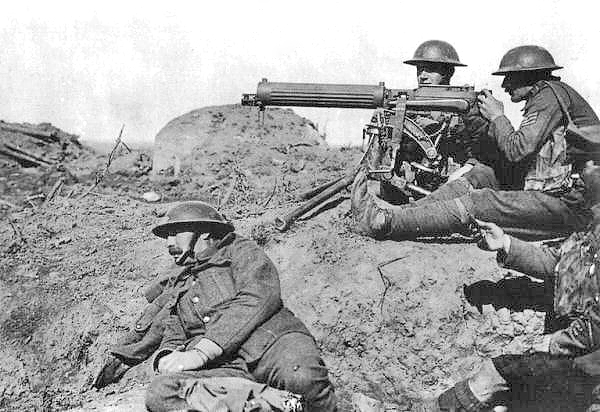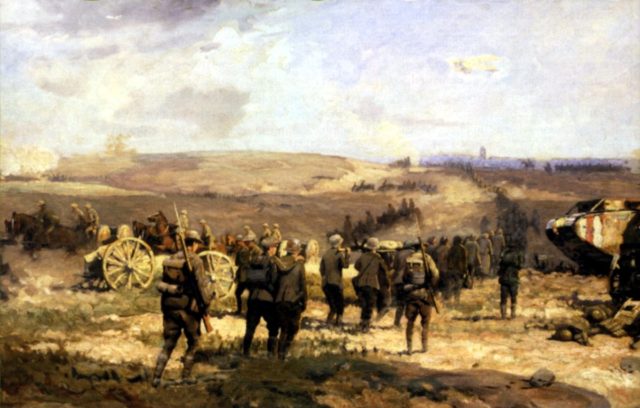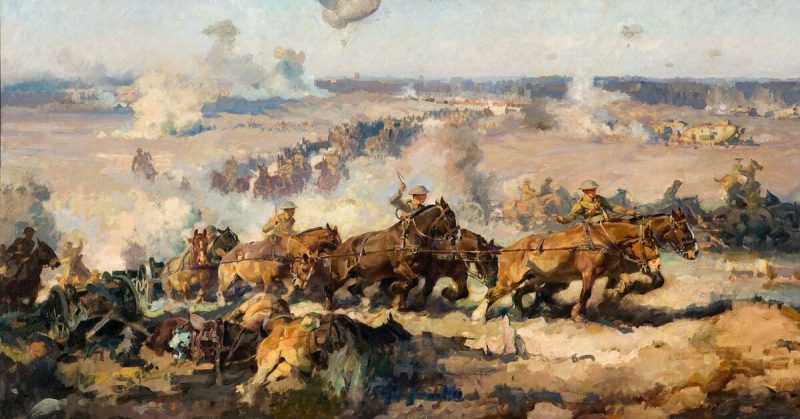In August 1918, the Allied forces began their final great push of the First World War. Later known as the Hundred Days Offensive, this series of advances brought the German military to their knees and the German government to the negotiating table.
It began with one remarkably successful operation; the Battle of Amiens.
Preparing for Battle
The Allies brought enormous resources to bear for the offensive. French, Australian, and Canadian troops were lined up on the Somme near Amiens. 700 pieces of heavy artillery and 1400 field guns had been gathered. 324 battle tanks and 184 supply tanks were ready. Enemy artillery positions were carefully mapped ready to be taken out.
All was undertaken beneath a veil of secrecy. The presence of the Canadians, some of the Allies most successful troops, was kept a secret from the enemy. To hide their presence, a unit of Canadians was prominently deployed at Ypres, then covertly whisked away to the attack zone after the Germans had seen them.
A Short Bombardment
At 0420 on August 8, the Allied artillery opened fire. They focused on the German artillery batteries, trying to take them out before they could hit Allied troops. It was a short, sharp bombardment, in contrast to the heavy barrages that had characterized the war so far. A creeping barrage of only three minutes duration lifted as the advance began.
Initial Advances
The Germans were already at a disadvantage. In the preceding five months, they had at first made significant progress but had then been driven back. They were not in the heavily built defensive positions they had been using for years.
The unexpectedly short bombardment, combined with the secrecy under which the troops had gathered, surprised the Germans.
In the initial assault, these two factors brought success. The Australians took their first objective by 0700 and their second by 1030. The Canadians had farther to advance but caught up with the Australians by 1100.

Struggles and Setbacks
The German field artillery put up some of the stiffest resistance. Stubbornly fighting to hold their ground, they did enormous damage to the Allies and particularly their tanks. Although the tanks did well, 100 of them were destroyed by the Germans while 200 were rendered useless due to accidents and breakdowns.
The Canadian advance stalled at its southern end due to German resistance. The north end of the Australian line had to slow down as the British on their flank had not yet taken their objective.
Despite this, most of the advance was a huge success. However, this created its own problems. By early afternoon the Allies had advanced between six and eight miles. The heavy guns were too far behind to support them.
At Last the War of Movement
The breakthrough Field Marshal Haig had long been waiting for had arrived. The war of movement had finally begun after four years of stalemate.
The problem for the Allies was that they were used to the slow grind of trench fighting. The infantry did not know how to make the most of the unexpected opportunity to move quickly. Tanks and cavalry were meant to work together but could not. Each fought best in different conditions. Machine-guns were deadly to cavalry but perfect targets for tanks. In the open, cavalry could race ahead while the tanks slowly lumbered.
Working separately, each arm of the Allied forces had its successes that day. It was not perfect, but it was more than had been achieved to date.
Cavalry Charges
There was an irony to the success of the cavalry on August 8, 1918. Later, commentators said the war had proven cavalry were useless in modern armies. On the day of the war’s most dramatic breakthrough, the cavalry finally did what they were meant to have done in 1914.
They charged through the gaps in the German lines. The Canadian Cavalry Brigade took Beaucourt-en-Santerre. The 15th and 19th Hussars charged ahead of the Canadians at Guillaucourt, seizing trenches and holding them until the infantry arrived. The 5th Dragoons captured 600 prisoners and an 11-inch railway gun.

In the Air
At the start of the day, mist hampered the activities of the Royal Air Force (RAF). As the weather cleared, they flew into action. Over the course of 205 sorties, they supported infantry attacks and bombed bridges to cut off the German retreat.
The German air fleet met them, inflicting heavy losses. Among those in the air was the Flying Circus, the elite unit of the late Red Baron von Richthofen, now led by Hermann Göring.
The RAF lost 44 aircraft and had 52 seriously damaged.
The Black Day of the German Army
General Erich Ludendorff would call this “the black day of the German Army.” They lost around 30,000 men, including 8,000 captured by the Australians and 5,000 by the Canadians. They also captured 334 German guns between them.
It was the most significant defeat the Germans had suffered since the start of the war, and it was only the beginning of the Allied assault.
For the Allies, it was a heartening success after years of hardship and the disasters of the spring.
A Prudent Halt
Field Marshal Haig kept the pressure on the Germans for two more days.
By then, things were getting difficult for the Allies. The artillery was out of range to support advances. Supply lines were overextended. Troops were not exhausted, but they were weary.
There were no signs the Germans were preparing a counter-attack. After their spring offensive, they lacked the resources. An argument could be made for pushing on.
In a moment of singular prudence, Haig called a halt to the initial offensive. It was time to rest and regroup. These successes could be continued another day, and continue they did.
Source:
Martin Marix Evans (2002), Over the Top: Great Battles of the First World War.
